Indoor plants have become increasingly popular as people seek to improve air quality, reduce stress, and create a more inviting living space. However, choosing the right pot size for your indoor plants is a crucial factor in ensuring their healthy growth and longevity. Selecting the appropriate pot size involves considering various factors, such as plant species, growth rate, and root system, as well as the pot material and its unique properties.
In this comprehensive guide, we delve into the science behind pot size selection, explore the different pot materials and their advantages and disadvantages, and provide practical tips to help you make the best choice for your beloved indoor plants. By understanding the importance of pot size and its impact on plant health, you can create a thriving indoor garden that enhances both the aesthetic and environmental quality of your living space.
How does pot size affect the health and growth of indoor plants?
The pot size you choose for your indoor plants can have a significant impact on their overall health and growth. Let’s explore the various ways pot size can influence your plants.
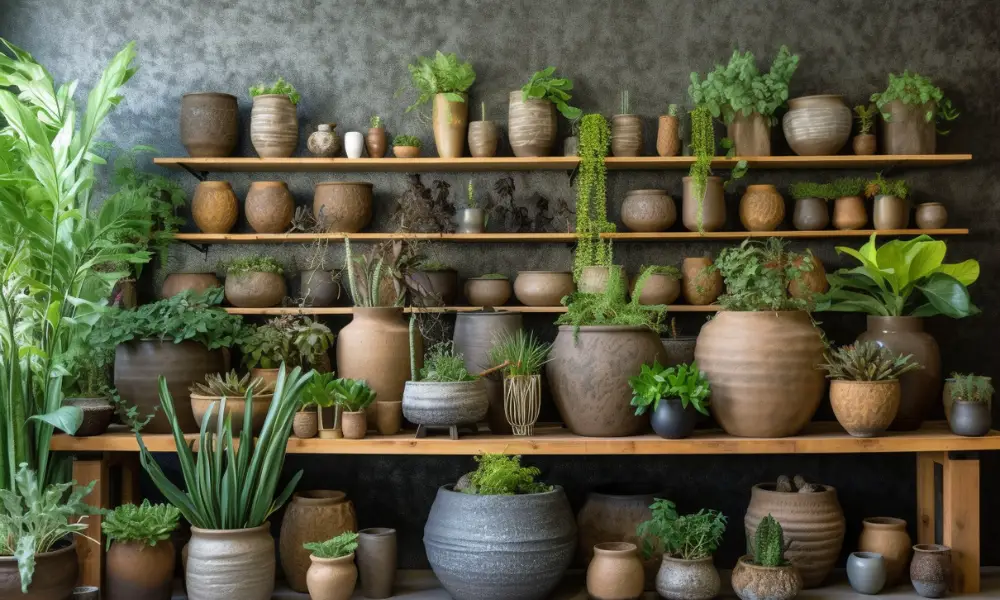
Root development and room for growth
An adequately sized pot allows the roots to develop and grow without constraints. A pot that’s too small can lead to root-bound plants, which can cause stunted growth and other health issues. Conversely, a pot that’s too large may retain excess water, leading to root rot or other problems.
Water retention and drainage
Proper drainage is crucial for plant health. A pot with the appropriate size and drainage holes ensures that excess water can escape, preventing root rot and other moisture-related issues. Additionally, smaller pots tend to dry out more quickly, while larger pots retain moisture for longer periods.
Nutrient availability
A pot that is too small may not provide enough room for the necessary nutrients to be available to the plant. In larger pots, nutrients can be more easily diluted, leading to deficiencies.
Stability and support
Lastly, the right pot size offers stability and support for your plant. A top-heavy plant in a small pot may become unstable and topple over, while a pot that’s too large for a small plant may not provide the support needed for healthy growth.
What are the different types of pots and materials available?
There is a wide variety of pot types and materials to choose from, each with its own set of benefits and drawbacks. Understanding these can help you make a more informed decision when selecting a pot for your indoor plants.
Ceramic pots
Ceramic pots are heavy, durable, and come in various shapes, sizes, and designs. They offer excellent insulation and moisture retention but may be prone to cracking due to temperature changes or physical impact.
Plastic pots
Plastic pots are lightweight, affordable, and widely available in numerous colors, shapes, and sizes. They retain moisture well but may not provide the best insulation and can become brittle over time.
Terracotta pots
Terracotta pots are made from porous clay, which helps regulate moisture levels by allowing water to evaporate through the pot’s walls. These pots are suitable for plants that prefer drier conditions, but they can be heavy and prone to chipping or breaking.
Metal pots
Metal pots are durable, stylish, and available in various designs. However, they can heat up quickly, potentially harming plant roots, and may rust over time.
Wood pots
Wood pots provide excellent insulation and a natural, rustic aesthetic. They can be heavier than other options and may rot or degrade over time if not properly treated or maintained.
Fabric pots
Fabric pots, also known as grow bags, are made from breathable materials that promote healthy root growth and prevent overwatering. They are lightweight and portable but may not be as durable or aesthetically appealing as other pot types.
Comparison table of different pot materials
| Material | Insulation | Weight | Moisture Retention | Durability | Aesthetic Appeal |
|---|---|---|---|---|---|
| Ceramic | Excellent | Heavy | Good (glazed) / Moderate (unglazed) | Moderate (prone to cracking) | Wide range of designs and colors |
| Plastic | Fair | Light | Good | Moderate (can become brittle) | Wide variety of colors, shapes, and sizes |
| Terracotta | Good | Heavy | Moderate | Moderate (prone to chipping) | Natural, earthy appearance |
| Metal | Poor | Light to moderate | Fair | Good (except for rusting) | Stylish and available in various designs |
| Wood | Excellent | Moderate to heavy | Good | Moderate (can rot if not treated) | Natural, rustic appearance |
| Fabric | Fair | Light | Moderate | Good (reusable) | Limited designs and styles available |
By considering the various pot materials and their unique properties, you can make a more informed decision when selecting the perfect pot for your indoor plants. Keep in mind your plant’s specific needs, your indoor environment, and your personal aesthetic preferences to find the ideal pot material for your situation.
How can you determine the appropriate pot size for various types of indoor plants?
Selecting the right pot size for your indoor plants is crucial to ensuring proper root development and overall plant health. To determine the appropriate pot size, consider factors such as the plant’s species, growth rate, root system, and specific needs. By understanding these aspects, you can provide your plants with the best possible growing environment. Here, we examine the factors that influence pot size selection and offer practical tips for determining the ideal pot size for various types of indoor plants.
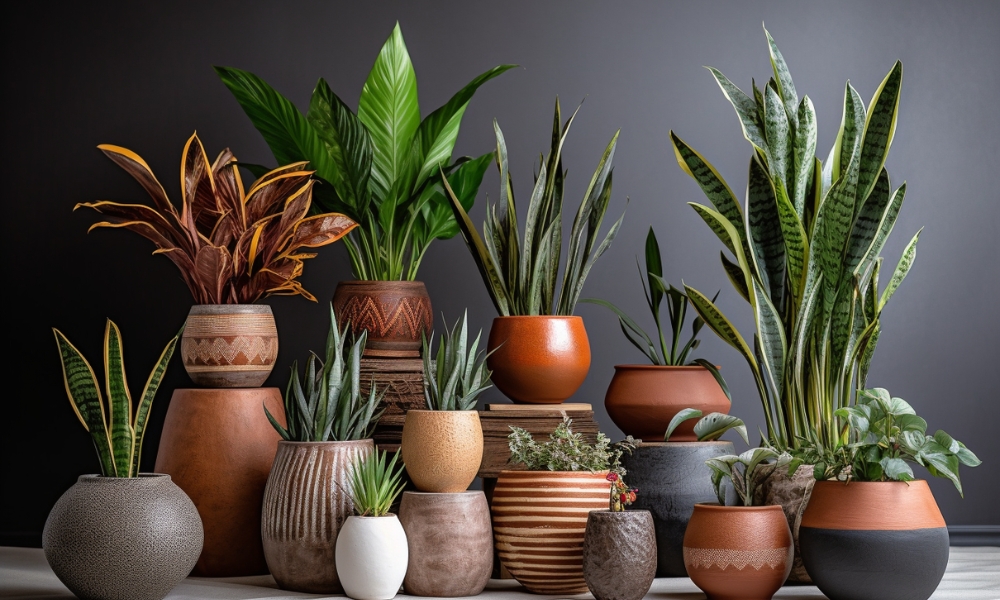
Plant species and growth habits
Each plant species has unique growth habits and requirements that should be taken into account when selecting a pot size. Fast-growing plants may require larger pots or more frequent repotting, while slow-growing or smaller plants may be better suited to smaller pots.
For example, philodendrons are known for their rapid growth and expansive root systems, requiring larger pots to accommodate their growth. On the other hand, succulents generally grow slowly and have compact root systems, making smaller pots more suitable.
Research your specific plant species to understand its growth habits and requirements. Consult reputable sources, such as gardening books, horticultural websites, or local nurseries, to gather information on the ideal pot size for your plant.
Root system characteristics
Understanding the characteristics of your plant’s root system can help you determine the appropriate pot size. Some plants have shallow root systems, while others have deep or extensive roots that require more space to spread out.
For example, snake plants (Sansevieria) have relatively shallow root systems, making them suitable for shallow pots. In contrast, fiddle leaf figs (Ficus lyrata) have extensive root systems that benefit from larger, deeper pots to promote healthy growth.
Inspect your plant’s root system when repotting or during routine maintenance to assess its growth and health. If you notice the roots becoming crowded or circling around the edges of the pot, it may be time to upgrade to a larger container.
Plant size and proportion
A general rule of thumb is to select a pot that is proportionate to the size of your plant. A pot that is too small can lead to root-bound plants, while a pot that is too large may cause the soil to remain too wet, leading to root rot.
Aim for a pot that is approximately 1 to 2 inches larger in diameter than the root ball for smaller plants and 2 to 4 inches larger for medium to large plants. This guideline provides enough space for root growth while maintaining a visually appealing plant-to-pot proportion.
Monitoring plant growth and health
Regularly monitor your plant’s growth and health to determine if it requires a larger pot or if the current pot size is appropriate. Signs that your plant may need a larger pot include:
- Root-bound appearance: Roots are visibly crowded, circling the pot’s edges, or growing out of the drainage holes.
- Stunted growth: The plant is not growing at the expected rate or has stopped growing altogether.
- Frequent watering: The plant requires more frequent watering than usual, indicating that the roots may have outgrown the pot’s capacity to hold water.
- Yellowing leaves or wilting: This can be a sign of nutrient deficiency or root stress due to a lack of space for growth.
By regularly assessing your plant’s growth and health, you can make informed decisions about when to repot or change pot size to ensure your indoor plants thrive.
Common mistakes to avoid when selecting a pot size for your indoor plants
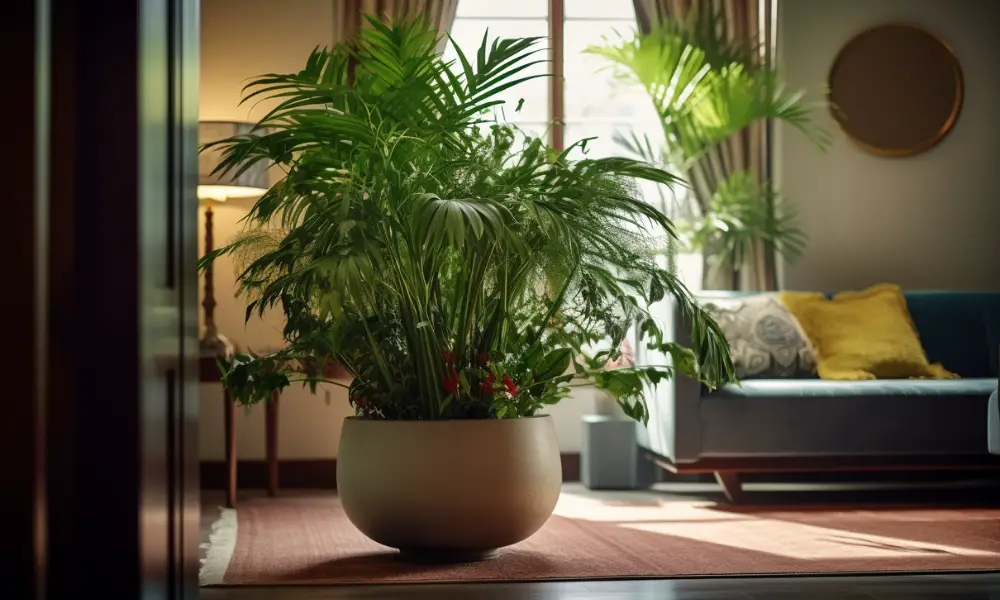
Choosing the right pot size for your indoor plants is crucial for their health and growth. Avoid these common mistakes to ensure your plants thrive. Down below you will find a list of common mistakes.
1. Choosing a pot that’s too small
A pot that’s too small can restrict root growth, leading to stunted growth and various health issues. Ensure there’s enough space for the plant’s roots to grow and spread without becoming cramped.
2. Choosing a pot that’s too large
Selecting a pot that’s too large for your plant can cause problems with moisture retention, potentially leading to root rot. Additionally, nutrients may become diluted in a larger pot, depriving your plant of essential nourishment.
3. Ignoring drainage requirements
Proper drainage is essential for plant health. Choose a pot with adequate drainage holes to prevent excess water from accumulating and causing root rot.
4. Neglecting material properties
Different pot materials have unique properties that can impact plant health. Consider factors such as insulation, moisture retention, and durability when selecting a pot material.
How often should you repot your indoor plants and how does this affect pot size selection?
Repotting your indoor plants is a necessary aspect of plant care, and understanding when and how to repot can help you choose the right pot size.
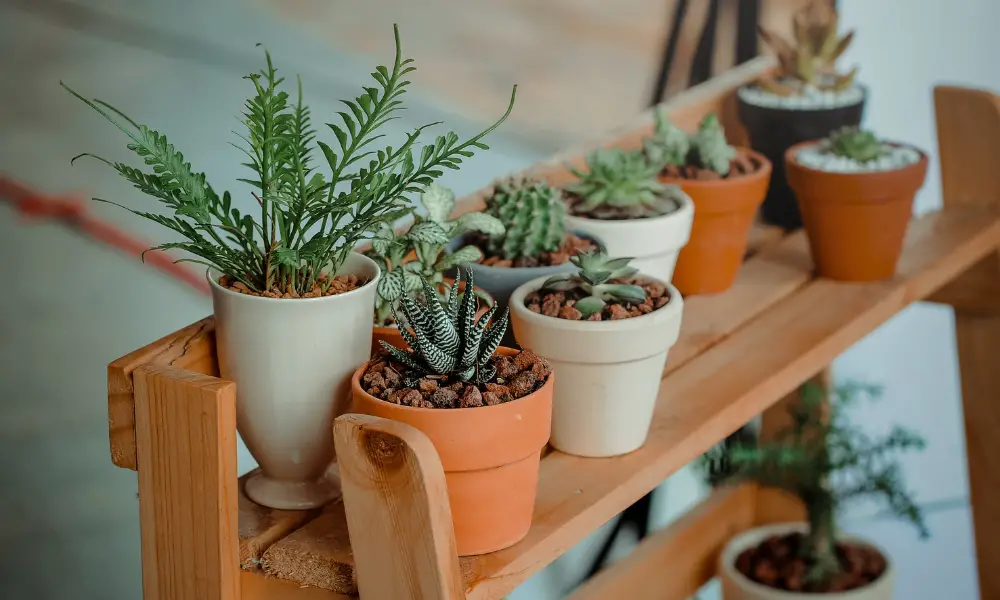
Signs that your plant needs repotting
Some signs that your plant may need repotting include stunted growth, roots growing out of the drainage holes, or a root-bound appearance when removed from the pot. Additionally, if your plant requires more frequent watering or becomes top-heavy and unstable, it may be time to repot.
Choosing the next pot size
When repotting, choose a pot that is one size larger than the current pot, allowing for sufficient room for root growth. Avoid making a drastic jump in pot size, as this can lead to issues with moisture retention and nutrient availability.
The repotting process
We have explained the step-by-step repotting process in a separate article. Lets have a quick recap. Carefully remove the plant from its current pot, loosening any compacted roots. Place the plant in the new pot, filling in with fresh potting soil as needed. Water the plant thoroughly after repotting to help settle the soil and reduce transplant shock.
Can you use alternative containers for your indoor plants?
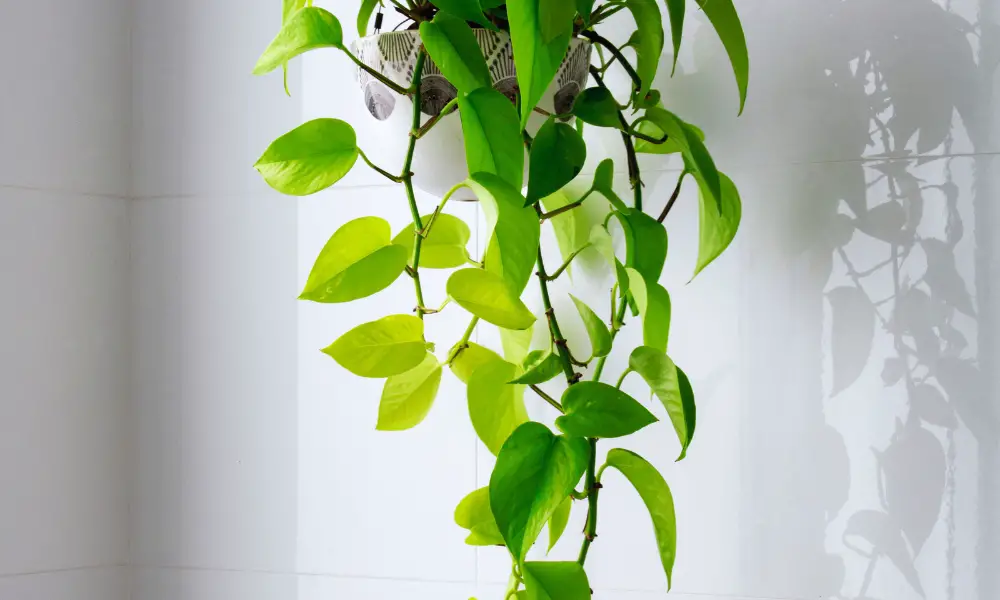
Alternative containers can offer unique and creative ways to display your indoor plants while still meeting their needs for drainage and ventilation.
Upcycling and repurposing items
Many everyday items can be upcycled or repurposed as plant containers, such as teacups, tin cans, or mason jars. Ensure that these containers have adequate drainage and ventilation to prevent issues with root health.
Unique container ideas
Some other unique container ideas include hanging planters, wall-mounted pots, or tiered plant stands. These options can add visual interest to your space while still providing a suitable environment for your plants.
Ensuring proper drainage and ventilation
Regardless of the container type, proper drainage and ventilation are crucial for plant health. Ensure your chosen container has drainage holes or add a layer of pebbles or gravel at the bottom to help promote proper drainage. Additionally, ensure that your plant has sufficient airflow, especially if using a closed or unconventional container.
How can you adapt pot size and type for specific indoor environments?
Different indoor environments may require unique considerations when selecting pot size and type. Keep the following factors in mind to ensure your plants thrive in their specific environment:
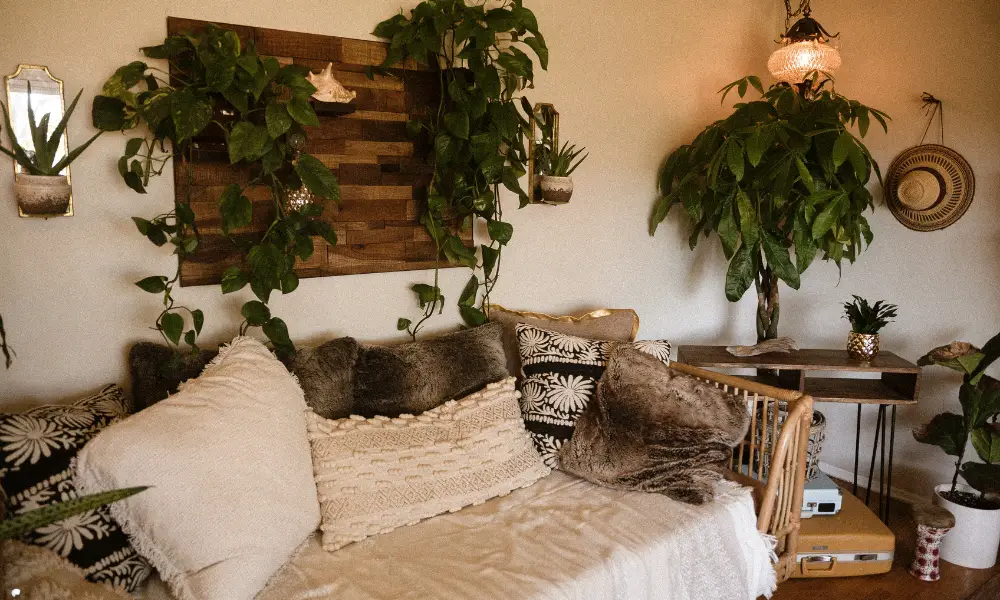
Considerations for low-light spaces
Plants in low-light areas may grow more slowly, requiring less frequent repotting. Additionally, consider using lighter-colored pots that reflect more light, potentially benefiting the plant.
Managing humidity and temperature
Some indoor environments may have higher humidity or temperature fluctuations, which can impact pot choice. Opt for pots made from materials that offer good insulation and moisture regulation, such as terracotta or ceramic.
Choosing pots for high-traffic areas
For high-traffic areas or spaces with limited floor space, consider using hanging or wall-mounted pots to keep your plants safely out of the way.
How do pot size and type impact the aesthetic appeal of your indoor plants?
The pot you choose can significantly impact the visual appeal of your indoor plants. Consider the following factors to create a harmonious and eye-catching display.
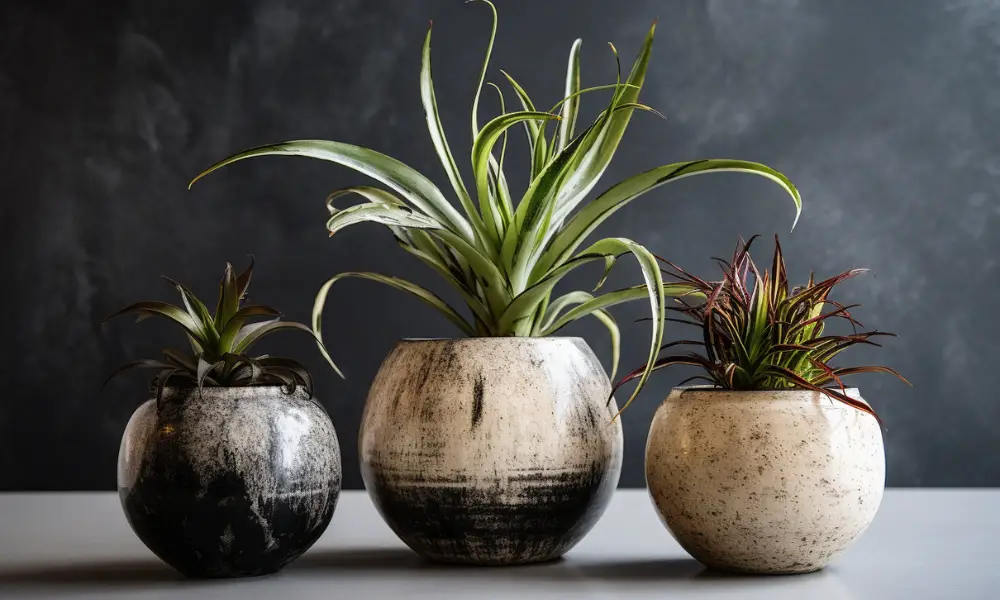
Creating visual harmony with pot and plant combinations
Choose pots that complement the size, shape, and color of your plant to create a cohesive and visually appealing display. For example, a tall, slender plant may look best in a tall, narrow pot, while a low, sprawling plant might be better suited to a wide, shallow container.
Utilizing color, texture, and shape
Experiment with various pot colors, textures, and shapes to create visual interest and enhance your interior design. A brightly colored pot can add a pop of color to your space, while a unique texture or shape can serve as a conversation piece.
Coordinating pots with interior design elements
Consider the overall style and color scheme of your interior design when selecting pots for your indoor plants. Choose pots that complement your décor, whether it’s minimalist, bohemian, modern, or traditional.
Conclusion
Choosing the right pot size for your indoor plants is essential for promoting healthy growth and creating an aesthetically pleasing display. By understanding the factors that influence pot size, material, and type, you can make more informed decisions and ensure your plants thrive in their indoor environment. Continue to learn and experiment with different pot sizes and materials to find the perfect fit for your unique collection of indoor plants.
